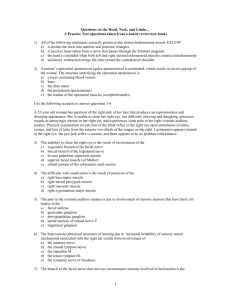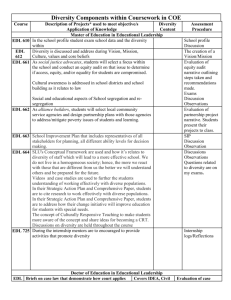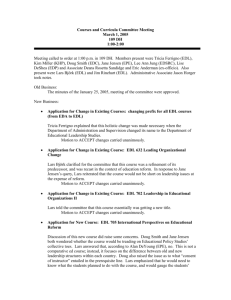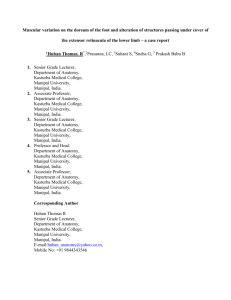Anatomy for Masseurs Extensor Digitorum Longus
advertisement
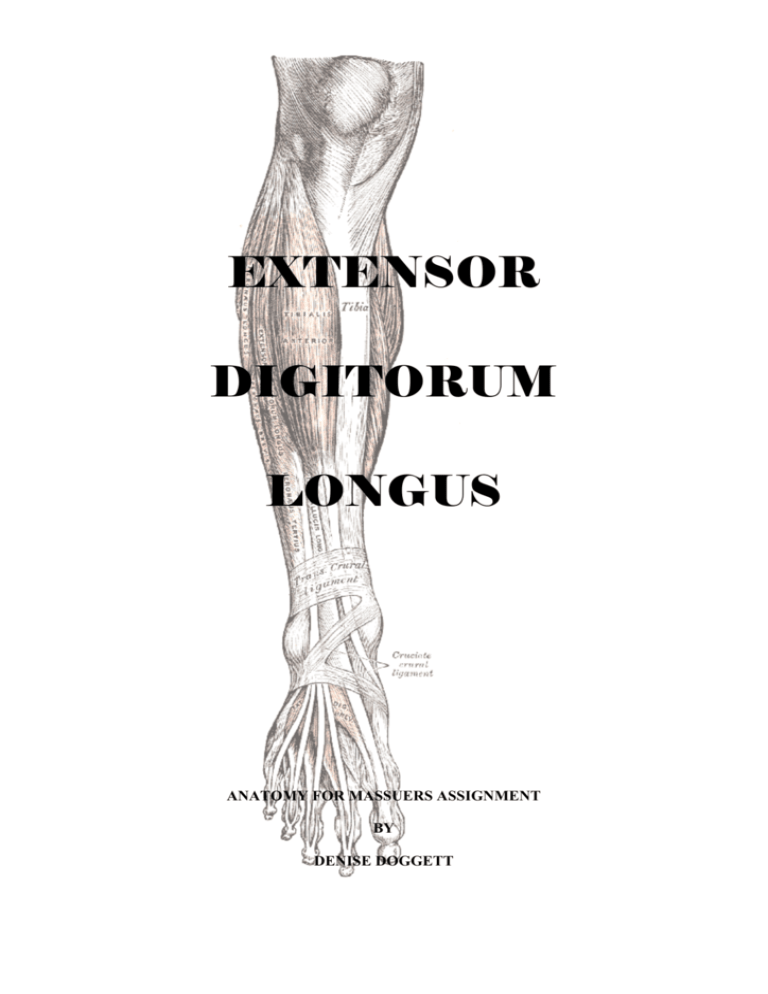
EXTENSOR DIGITORUM LONGUS ANATOMY FOR MASSUERS ASSIGNMENT BY DENISE DOGGETT Definition and Location: Extensor Digitorum Longus (EDL) is a muscle situated in the lateral section of the anterior compartment of the leg and is not to be confused with the Extensor Digitorum muscle of the forearm. The muscle arises from the lateral condyle of the tibia, the proximal portion of the interosseous membrane, the proximal ¾ anterior surface of the body of the fibula, deep fascia and intermuscular septa. It runs lateral to the tibialis anterior muscle. ( http://www.bartleby.com/107 ) EDL runs down the length of the leg travelling over the anterior of the talocrural joint, where it passes under the extensor retinaculum then divides into 4 tendons. The 4 tendons ‘suspend’ each of the 4 lesser toes at the proximal phalanx with the assistance of the extensor sling (sagittal bands). The extensor slings span either side of the tendon and are anchored to the volar (or plantar) plates of the metatarsal phalangeal joints. At the insertion, each of the 4 tendons divide into 3 slips. The central slip inserts into the base of the middle phalanx, whilst the two lateral slips unite and insert onto the distal phalanx. (http://www.wheelessonline.com/ortho/) (http://www.bartleby.com/107) Histology: There are three types of muscle tissue present in the human body: skeletal, cardiac and smooth. When discussing the body’s muscles we are looking at ‘skeletal muscle tissue’ which is the largest tissue in the body and accounts for some 40% to 45% of a persons total body weight. Skeletal muscle (striated) tissue is highly specialized for contractility and producing movement of internal and external body structures. (Porth 1998) The muscle cell consists of a membrane, many scattered nuclei and thousands of inner strands called myofibrils. Myofibrils contain component units called sarcomeres and these are the part that enables the cell to contract forcefully in response to nerve impulses. Within each sarcomere are two filamentary proteins called myosin and actin whose interaction causes contraction. Basically, during contraction, a sarcomere shortens as the actin filaments at each end of a central myosin filament slide toward the myosin’s centre. (http://members.shaw.ca/copingwithillness/musc.htm) Normal Gross Anatomy: • • • • • • Shape - Unipennate or unipenniform (wing feather shaped). Pennate muscles are the most common type of skeletal muscle and predominate when forceful movements are needed Size - Elongated and narrow (longus), averaging 30 – 50cm in the adult human Fibre orientation - Short, parallel, featherlike fibres which extend diagonally from the side of a long tendon Thickness - Thin muscle stretching the span between tibia and fibular Coverings - Myofascia. Also, extra support is given by the Deep Crural Fascia. It is thick and dense in the upper and anterior part of the leg, and gives attachment, by its deep surface, to the Tibialis Anterior and EDL. Attachments - Origin: Tibia, fibula, interosseus membrane, intermuscular septa Insertion: Dorsum of the lesser toes (Hamilton/Luttgens 2002) (Tracey, David J) (http://www.bartleby.com/107) Associated Structures: Blood Supply Nerve Supply Bony Levers Adjacent Muscles Synergistic Muscles Joints Bursae Floors Retinacula Anterior tibial artery - passes anterior between the tibia and fibula, superior to the interosseous membrane descending along the anterior surface of the membrane. Terminates as Dorsalis pedis artery on the dorsum of the foot. It is palpable at this point between the tendons of the EDL and Extensor Hallucis Longus. Deep Fibular Nerve - descends on the anterior surface of the interosseous membrane (accompanied by the anterior tibial artery). The deep and superficial fibular nerve are branches of the sciatic nerve which has its spinal roots at L4, L5 and S1. Tibia and foot with the talocrural joint as the fulcrum. (i.e. as in normal gait). The tibia receives the weight of the body from the femur and transmits it to the foot. It is second only to the femur in size and strength. (The fibula is not weight-bearing as it is a supporting bone with several muscle origins). Tibialis Anterior (medially), Fibularis Longus and Brevis (laterally), Extensor Hallucis Longus and Fibularis Tertius (deep). Extensor Digitorum Brevis (toe extension). Tibialis Anterior, Fibularis Tertius and Extensor Hallucis Longus (dorsiflexion at ankle). EDL spans proximally from the inferior surface of the tibiofibular joint. It’s tendons span the anterior of the talocrural joint, over the intertarsal joints on the dorsum of the foot, moving distally over the tarsometatarsal and metatarsophalangeal joints (of the lesser 4 toes), to insert into the second and third interphalangeal joints. A common synovial sheath (elongated bursa) is located on the anterior surface of the ankle and surrounds the four tendons of EDL. Distal two-thirds of the anterior surface of the tibia. Function is to hold muscle and tendon down to prevent ‘bowstringing’. The Extensor Retinaculum is divided into a superior band and ‘Y’ shaped inferior band. The stem of the Y band is on the medial side and is continuous with the Fibular Retinaculum. Passing under the retinaculum are: EDL tendon, Tibialis Anterior, Extensor Hallucis Longus tendon, Fibularis Tertius tendon, Deep Fibular Nerve and Anterior Tibial Vessels. (http://www.dartmouth.edu/-anatomy/arteries-nerves) (http://www.cgcharacter.com/Anatomy) (http://www.med.nagasaki.jp/radiolg) (Marieb 2004) (http://www.gla.ac.uk/ibls/fab/glossary) (Snell 1978) (Lumley 1990) Function: EDL is made up of a combination of both fast and slow-twitch fibres. With its origin from the tibia, it uses this bone as a lever (along with other leg muscles) to assist with propulsion of the body. During normal gait, EDL alternates between tonic and phasic. During swing phase, (between toeoff and heel-strike) EDL assists with dorsiflexion whilst the plantar flexion muscles remain phasic. Moving through to the support phase, (heel strike to toe-off) EDL works conjointly with the other ‘extensor’ group muscles briefly at both the beginning and the end of this forward propelling stage with both dorsiflexion and toe extension. EDL does not aid in knee or ankle stability. (http://moon.ouhsc.edu/dthompso/gait/kinetics/mmactsum.htm) (Hamilton/Luttgens 2002) In slow walking styles the function of the toes is not to exert propulsion forces but as stabilizing forces. In longer stride walking it is suggested that the toes are required to exert propulsion forces. The main actions of EDL are: • Extension of the lesser 4 toes • Weak dorsiflexion and eversion at the ankle • Tauten the Plantar Aponeurosis It is one of a group of muscles known as ‘extensors’ which produce the action of dorsiflexion and eversion at the ankle joint. All muscles of the anterior compartment of the leg are dorsiflexors. Tibialis Anterior is the prime mover, with the assistance of EDL, Extensor Hallucis Longus and Fibularis Tertius. Fibularis Tertius is a small muscle which is not always present. It is usually continuous and fused with the distal part of EDL and can be classed as part of that muscle. (http://www.wheelessonline.com/ortho/) (Marieb 2004) (Rogers 1992) (Anderson/Keith/Novak 2002) EDL is the prime mover for extension of the toes. It is assisted by Extensor Digitorum Brevis (which is the only muscle located on the dorsum of the foot and is situated deep to the tendons of EDL). (Marieb 2004) (http://www.gpnotebook.co.uk) Morphology: Any paralysis to the anterior compartment muscles through injury to the deep fibular nerve causes ‘foot drop’. This greatly affects the gait as the legs must be lifted unusually high to prevent dragging of, or tripping over, the toes. A common problem with EDL is contracture (permanent state of muscle contraction). This initially develops dorsomedially at the metatarsophalangeal joint and eventually forms in the EDL tendon (and the skin overlying the joint) causing a hyper extended or overlapping fifth toe. Surgery is required to remedy this problem. Other common variations for EDL are connected with the actual tendons and slips: 1. 2. 3. 4. Slips may be missing Slips are joined onto the first phalanx A connecting slip from the innermost tendon to the Extensor Hallucis The muscle was found in a case of a deformed limb, with four tendons, one to the second toe, one to the fifth, and two to the forth toe 5. A slip to the fifth metatarsal coexisting with the fibularis tertius 6. Slips from this muscle and fibularis tertius to the anterior end of the fifth metatarsal bone 7. The outermost tendon of the longus has been found joined to that of the brevis by a cross band (Calais-Germain 1993) (www.vh.org/adult/provider/anatomy/AnatomicVariants) (http://www.emedicine.com/orthoped/topic388.htm) REFERENCES Marieb, EN. (2004). Human Anatomy and Physiology (Sixth Edition). San Francisco: Pearson Benjamin Cummings Calais-Germain, B. (1993). Anatomy of Movement (English Language Edition). Seattle: Eastland Press Inc Tracey, David J. BSc PhD (Chief Consultant). Anatomica. Australia: Random House Pty Ltd Snell, Richard S. MD PhD. (1978). Atlas of Clinical Anatomy. Boston: Little, Brown and Company Lumley, John SP. (1990). Surface Anatomy. USA: Churchill Livingstone Rogers, AW. (1992). Text Book of Anatomy. USA: Churchill Livingstone Anderson, DM; Keith, J and Novak PD. (2002). .Mosby’s Medical Nursing and Allied Health Dictionary (Sixth Edition). Missouri: Elsevier Mosby Porth, CM and Contributors. (1998). Pathophysiology (Fifth Edition). Philadelphia: LippincottRaven Publishers Hamilton, N and Luttgens, K. (2002). Kinesiology (Tenth Edition). New York: McGraw-Hill Gray’s Anatomy via Bartleby.com – Great Books Online. Retrieved October 2005 from http://www.bartleby.com/107 Wheeless’ Textbook of Orthopaedics. Retrieved October 2005 from http://www.wheelessonline.com/ortho/extensor_digitorum_longus General Practice Notebook. Retrieved October 2005 from http://www.gpnotebook.co.uk Virtual Hospital, Encyclopaedia of Human Anatomic Variation. Retrieved October 2005 from http://www.vh.org/adult/provider/anatomy Dartmouth College, Dartmouth Medical School. Retrieved November 2005 from http://www.dartmouth.edu/-anatomy/arteries-nerves Nagasaki University School of Medicine, Department of Radiology. Retrieved November 2005 from http://www.med.nagasaki.jp/radiolg cgCharacter Software. Retrieved November 2005 from http://www.cgcharacter.com/Anatomy Schroeder, Stephen M (DPM), Fifth Toe Deformities. Retrieved November 2005 from http://www.emedicine.com/orthoped/topic388.htm Tillier, B, Simplified Overview of Muscles. Retrieved November 2005 from http://members.shaw.ca/copingwithillness/musc.htm Parent Directory – Glossary search. Retrieved November 2005 from http://www.gla.ac.uk/ibls/fab/glossary Muscle Activity During the Gait Cycle. Retrieved November 2005 from http://moon.ouhsc.edu/dthompso/gait/kinetics/mmactsum.htm MORPHOLOGY Photo (1) Photographs (1) and (2) showing result of Extensor Digitorum Longus tendon contracture. Photo (2) Photo (3) This photograph (3) clearly shows the taut tendon of EDL associated with contracture (causing the overlapping, or hammer, toe) http://www.emedicine.com/orthoped/topic388.htm


